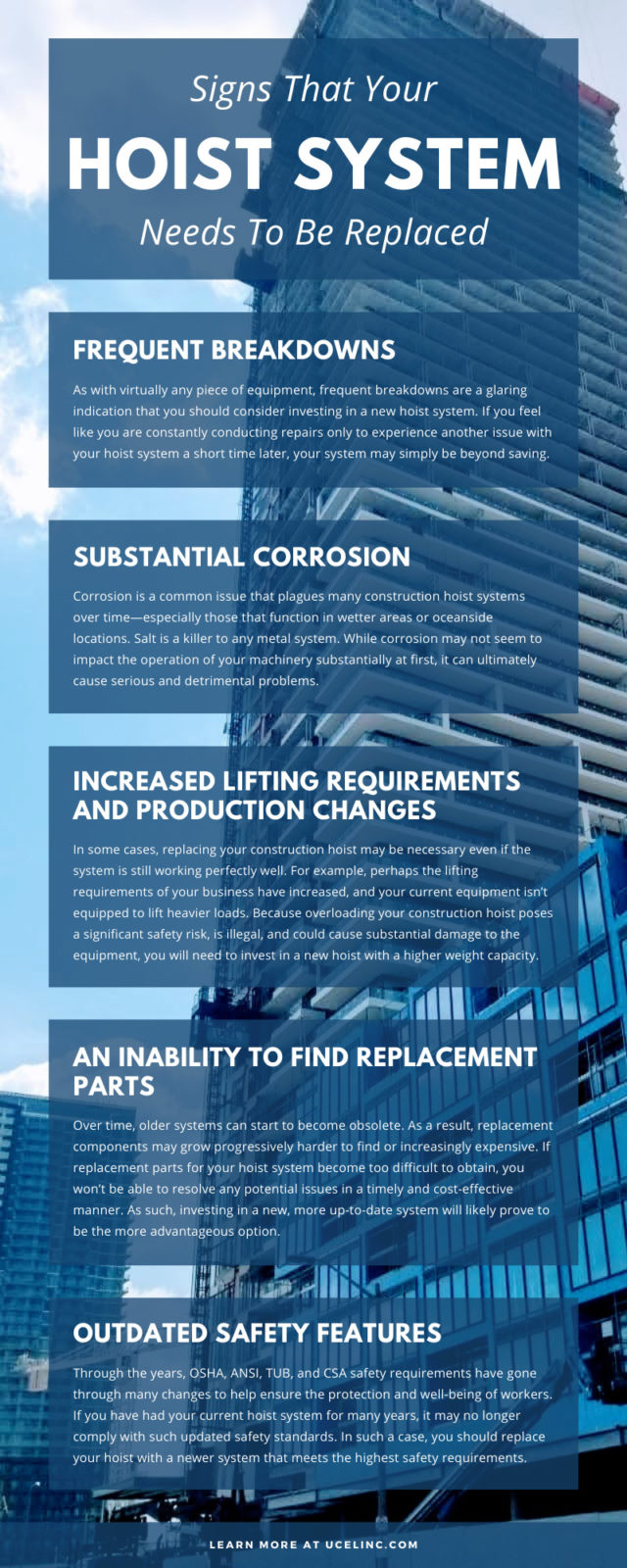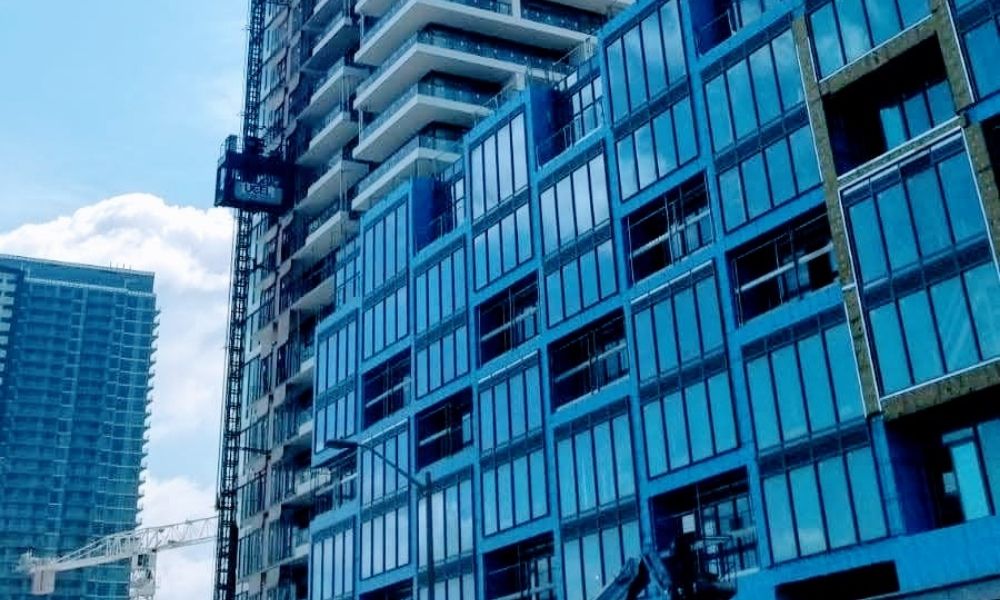A construction hoist system is an essential piece of equipment on many construction sites for the vertical transportation of equipment, materials, and personnel. A construction hoist can have numerous advantages, such as increased safety, heightened productivity, and reduced costs. However, such benefits are only possible if the hoist system works properly. If a construction hoist has sustained damage or significant wear and tear, the opposite of these advantages could occur. To avoid such negative effects, you should know when to call it quits on your current hoist and purchase a replacement. Below, we will address some of the most common signs that your hoist system needs to be replaced.
Frequent Breakdowns
As with virtually any piece of equipment, frequent breakdowns are a glaring indication that you should consider investing in a new hoist system. If you feel like you are constantly conducting repairs only to experience another issue with your hoist system a short time later, your system may simply be beyond saving. For some brands, you can reach this high cost-of-ownership in just 10 years. For more reputable brands, you can reach 30 years or more before cost-of-ownership tips the scales. However, some major developers in key markets, such as New York City, Houston, Boston, and Los Angeles, are demanding new or close-to-new equipment baked into clauses right in the contract.
Plus, such frequent repairs will likely start to rack up a significant bill and cause your company a substantial amount of costly downtime. When considering the financial strain that a finicky construction hoist system can place on your company, investing in a new system that runs smoothly will likely prove to be economically advantageous. Sometimes, the best solution is to place older equipment in lower-traffic applications to reduce wear and tear.
Substantial Corrosion
Corrosion is a common issue that plagues many construction hoist systems over time—especially those that function in wetter areas or oceanside locations. Salt is a killer to any metal system. While corrosion may not seem to impact the operation of your machinery substantially at first, it can ultimately cause serious and detrimental problems. For example, corroded construction hoist systems can experience a loss of mechanical strength, reduced structural integrity, and electrical issues, just to name a few. As such, if the corrosion advances significantly, you will likely need to replace the machine to protect the safety of your workers. One thing you can do from the buying stage is to buy equipment that is high-quality, hot-dip galvanized (not all galvanization is equal!), or sand-blasted and coated with multiple powder coats to extend the life of the metal substrate.
Unfortunately, signs of corrosion often go without notice for a long time until the system has experienced substantial damage. As such, it’s important to inspect your construction hoist on a regular basis to identify corrosion as early as possible. When inspecting your hoist system for corrosion, make sure to follow the specific guidelines outlined by the Occupational Safety and Health Administration (OSHA). Such instructions and standards exist to ensure safe working conditions and will help you better identify and address any risk factors regarding your equipment. A common test is to “ultrasound” metals, which allows you to determine their current thickness. Comparing this to their original manufactured specifics and the allowable wear per the manufacturer guidelines can tell you if you need a replacement.
Increased Lifting Requirements and Production Changes
In some cases, replacing your construction hoist may be necessary even if the system is still working perfectly well. For example, perhaps the lifting requirements of your business have increased, and your current equipment isn’t equipped to lift heavier loads. Because overloading your construction hoist poses a significant safety risk, is illegal, and could cause substantial damage to the equipment, you will need to invest in a new hoist with a higher weight capacity.
On the other hand, maybe your production needs have changed so that you now need to use your construction hoist more frequently. If your current system was not designed to handle the additional wear and tear that comes with performing more frequent lifts, investing in a more durable system that can meet higher production demands is essential. Not all brands offer equal quality. Some brands are built to be used on only a few projects in low-traffic applications at low heights—even if the manufacturer says they can handle more. Always be cautious with what you’re buying; go for products with a proven track record with your application.
An Inability To Find Replacement Parts
Over time, older systems can start to become obsolete. As a result, replacement components may grow progressively harder to find or increasingly expensive. If replacement parts for your hoist system become too difficult to obtain, you won’t be able to resolve any potential issues in a timely and cost-effective manner. As such, investing in a new, more up-to-date system will likely prove to be the more advantageous option.
Outdated Safety Features
Another sign that your hoist system needs to be replaced is if it has outdated safety features. Through the years, OSHA, ANSI, TUB, and CSA safety requirements have gone through many changes to help ensure the protection and well-being of workers. If you have had your current hoist system for many years, it may no longer comply with such updated safety standards. In such a case, you should replace your hoist with a newer system that meets the highest safety requirements. Sometimes, it’s possible to work around these safety factors. For example, when the New York City DoB demanded additional sensors for extended cars, we were able to implement many different options for clients to meet this code without involving an OEM or a new construction hoist system.
Inefficiencies
In addition to having enhanced safety features, more up-to-date construction hoists may also operate more efficiently. As with pretty much any industry, time is money on a construction site. If your production times are slow, you may lose business or end up paying far more than necessary on labor costs.
As such, any inefficiencies in your current hoist system could ultimately cost your company a substantial amount of money. To reduce the total cost of your projects, consider investing in a newer system equipped with the latest technology. One such concern in the industry is the power draw in markets where construction sites are being delivered less amperage than they would otherwise demand. We have run into this frequently in California and New York State. Implementing VFD-controlled construction hoists that are programmed to run more efficiently with slower ramp parameters has reduced power requirements to lift loads, reducing the need for costly additional electricity or generators.
If you determine that your current hoist system needs replacing, look no further than UCEL, Inc. We have over 55 years of experience designing, building, and installing top-quality construction equipment. From Boston and New York City to Los Angeles and San Diego and across Canada, our construction hoist units have stood up against some of the most demanding super-high-rise markets in the continent. We’ve completed projects over 1,000 feet tall, such as the Hudson Yards Project in New York City, where we were the preferred equipment supplier for most of the towers throughout all phases of construction. If you aren’t ready to purchase a new system, we offer construction hoist rentals as well. To learn about how renting or buying our systems can help save your company time and money while delivering uncompromising safety, contact us today.

